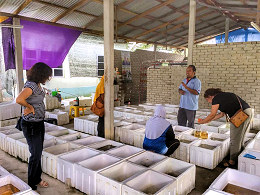Planning and operation
Production
 Betta fish need minimal facility to be
maintained and that is one of the main reasons it is favourite by many aquarium hobbyist. Although the price of Betta can peak up at one point, the price can
easily drop when there is new variety coming up. Therefore for many Betta farms, producing new varieties and keeping up with market trends is crucial in sustaining
the farm production. In Betta Lover farm, a new variety could be produced every two months and depending on the trait that is aimed for, the cross breeding process
could take up to 6 months.
For the customer, it may mean a wait of three and half months, per
cycle, to get the right variety.
Betta fish need minimal facility to be
maintained and that is one of the main reasons it is favourite by many aquarium hobbyist. Although the price of Betta can peak up at one point, the price can
easily drop when there is new variety coming up. Therefore for many Betta farms, producing new varieties and keeping up with market trends is crucial in sustaining
the farm production. In Betta Lover farm, a new variety could be produced every two months and depending on the trait that is aimed for, the cross breeding process
could take up to 6 months.
For the customer, it may mean a wait of three and half months, per
cycle, to get the right variety.
The production area is all indoors: the Betta or broodstock are kept in the exhibition unit. The males are kept in 1 litre individual containers and the female Betta fish are kept in 3 litre plastic containers. There are approximately 300 of these smaller containers in this display area. Local buyers usually will look through the variety of Betta that are being displayed in these containers, and buy them directly or place an order for a larger quantity.
In nursing area, the juveniles of the fish are being kept in a modified 30-L polystyrene box with plastic lining or a water proof coating (these are the "tanks" used for juvenile fish). There are 50 of these tanks. This section also contained several cemented tanks for larger size fish.
Hatchery
 ln the hatchery area, the broodstock is being kept in
one
and three litre container while the breeding will be conducted in a
10l holding unit. The breeding is all being done naturally by
placing the two individuals in this holding unit and monitored for
courtship behaviour.
ln the hatchery area, the broodstock is being kept in
one
and three litre container while the breeding will be conducted in a
10l holding unit. The breeding is all being done naturally by
placing the two individuals in this holding unit and monitored for
courtship behaviour.
The early life stages of Betta require smallest size of live feed (Infusoria) and later Moina sp., the live feed of preference for the fry, which is usually sourced from local supplier or caught by the owner himself from its natural habitat in neighbouring area. Daphnia and Artemia are also used by fish breeders. Moina is of a smaller size than Daphnia, with a higher protein content, and of comparable economic value. The limitation at Betta Lover farm is feed production; due to lack of space and manpower, the owner does not have a suitable set-up that can provide an efficient supply of feed for the production at this stage and sourcing local Moina, keeps costs relatively low.
Ongrowing
Adult Betta can reached up to 7 cm when they are fully grown. During this stage, adult Betta can response well to artificial diet as long as the size of the pellet is appropriate to their mouth size. Often Betta will be fed with microgranules or pellets. The size of the stomach is relatively small, so one single Betta will only need few granules twice a day and this is very cost effective for Betta Lover farm.

Marketing
Betta Lover Farm supplies local and national customers. At present, it is a small scale production with potential to expand, but is limited by space and manpower as well as other factors, such a lack of feed production on-site.
Marketing Trends for Betta fish (US imports) reveal, that Betta fish are one of the most common fish found in pet stores. These fish are:
- Purely ornamental
- Most common, one of the cheapest fish out there, $1-$3 per fish
- Advertised as a very easy “starter pet”; customers are often told that Bettas...
- can live in a 0.4 gallon tank
- can thrive in low water volumes
- do not need to be fed as often - For this reason, many Betta owners maltreat their fish without even knowing it.
Common conditions at present are:
- majority of exports are made out of East-Asian fish farms (cheaper than U.S. farms/breeders)
- mass fish producers use minimum supplies to decrease outgoing expenses - Transportation:
- require oxygen and water
- Bettas are packaged individually in small plastic bags containing blue tinted water, which is
believed to have chemicals that sedate the fish - U.S. Postal Service requirement: 1⁄3 water, 2⁄3 air, plastic thickness at least 0.1 mm
The fish must survive in these conditions for several days, if delayed sometimes up to more than a week. It is quite common, that many fish are dead or ill upon arrival at pet stores.